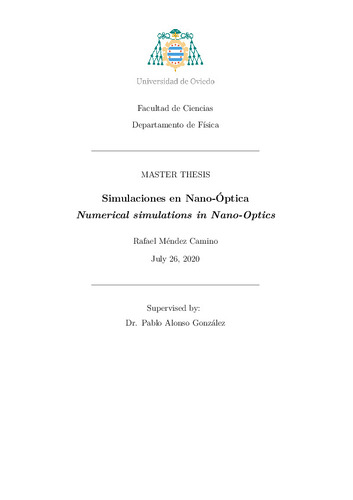Simulaciones numéricas en Nano-Óptica
Autor(es) y otros:
Director(es):
Fecha de publicación:
Serie:
Máster Universitario en Física Avanzada: Partículas, Astrofísica, Nanofísica y Materiales Cuánticos
Descripción física:
Resumen:
Surface polaritons (hybrid light-matter waves occurring in metal-like materials) allow the study of light at the nanoscale. This is because, as a difference to what happens with light in conventional optics, surface polaritons allow for beating the diffraction limit, opening the door for controlling light at the nanoscale. In this work, we will study from numerical simulations how surface polaritons propagate within different environments, including strongly anisotropic media. Particularly, we will study how surface polaritons reflect at boundaries with isotropic, uniaxial, and biaxial media, and analyze how different parameters, both from a physical and a more purely numerical point of view, affect the results obtained. However, the simulations will be performed with light (the excitation is straightforward in this case), being able to extrapolate all the results obtained directly to SPs. This study will allow us to explore a range of different exotic optical phenomena, such as anomalous reflections and back-reflections. Finally, as anisotropic back-reflection observations have yet not been achieved, we propose an experimental scenario based on our simulations that might allow its visualization. All this work was carried out using the commercial software COMSOL MULTIPHYSICS.
Surface polaritons (hybrid light-matter waves occurring in metal-like materials) allow the study of light at the nanoscale. This is because, as a difference to what happens with light in conventional optics, surface polaritons allow for beating the diffraction limit, opening the door for controlling light at the nanoscale. In this work, we will study from numerical simulations how surface polaritons propagate within different environments, including strongly anisotropic media. Particularly, we will study how surface polaritons reflect at boundaries with isotropic, uniaxial, and biaxial media, and analyze how different parameters, both from a physical and a more purely numerical point of view, affect the results obtained. However, the simulations will be performed with light (the excitation is straightforward in this case), being able to extrapolate all the results obtained directly to SPs. This study will allow us to explore a range of different exotic optical phenomena, such as anomalous reflections and back-reflections. Finally, as anisotropic back-reflection observations have yet not been achieved, we propose an experimental scenario based on our simulations that might allow its visualization. All this work was carried out using the commercial software COMSOL MULTIPHYSICS.
Colecciones
- Trabajos Fin de Máster [5283]
Ficheros en el ítem





